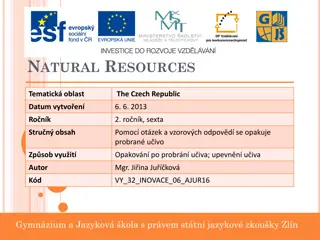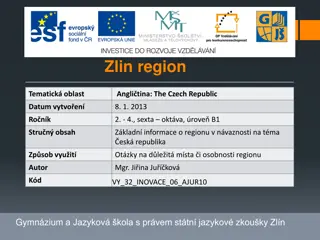Czech Republic and Nigeria: Bilateral Economic Relations
Nigeria, the largest economy in Africa, holds great economic potential for Czech Republic. This presentation explores the economic giant of Africa, the European Union's trade partnership with Nigeria, Czech industrial presence in the country, and current commercial relations. Insights on prospective economic sectors and collaboration opportunities are discussed for moving forward.
Download Presentation

Please find below an Image/Link to download the presentation.
The content on the website is provided AS IS for your information and personal use only. It may not be sold, licensed, or shared on other websites without obtaining consent from the author.If you encounter any issues during the download, it is possible that the publisher has removed the file from their server.
You are allowed to download the files provided on this website for personal or commercial use, subject to the condition that they are used lawfully. All files are the property of their respective owners.
The content on the website is provided AS IS for your information and personal use only. It may not be sold, licensed, or shared on other websites without obtaining consent from the author.
E N D
Presentation Transcript
Operational Variables, Validity, and Reliability R. Garner, DePaul University
Conceptual variables We can ask questions about variables that are conceptual. For example: How democratic are the countries of Latin America? How healthy are the eating habits of Canadians? Is there a relationship between firm size and the degree of racial equity in hiring practices?
Can we make them operational? If you look at the variables on the preceding slide, you will see that different people might define these terms differently and get into disagreements about what they mean democratic, healthy, racial equity. Can we define these terms by stating an operation of measurement a procedure that expresses what we mean in an unambiguous way?
Observation and measurement When we observe countries, how do we decide whether or not their political institutions are democratic? How do we know if food is healthy or not? How can we define racial equity in hiring and decide if it is being fulfilled by a company? WHAT ARE THE CRITERIA? WHAT IS THE PROCEDURE THE OPERATION THAT ALLOWS US TO DECIDE?
Binary or not? We have to specify whether the variable is a binary ( yes or no ) or a scale with several (or many) points. Some foods might clearly be healthy and others unhealthy, but maybe there are a number of in-between foods.
Where does this case fall on the scale and why? What criteria or criterion do we use to place the case on the scale, whether this is a binary scale or a scale with many points? How do I decide if this country is very democratic, somewhat democratic, not democratic at all? What do I look for to answer this question? Try to do it!
Examples of criteria In answering the question of the previous slide, you might have listed criteria such as: More than one party allowed to participate in elections Parties and candidates can represent a wide range of stands on issues A free press Competing parties have a chance of winning not always the same party in power Voting rights are broadly defined one person, one vote with few roadblocks to voting
From criteria to an operational variable Once we have a list of criteria, we might then create a scale for each of these (ranging from definitely present to definitely not present). We can place the scales for all the criteria together in an index. We can weight criteria differently. For each criterion, we might have to spell out how to observe political practices to decide if they meet the criterion how to go from observations to the conclusion that the criterion was met.
Validity and reliability Operational variables should involve procedures that are valid so that the measurement procedure matches what we intended the concept to mean. Operational variables should involve reliable procedures, so that different observers (and possibly at different times) will yield the same measurement result. Reliability is closely related to objectivity. This result exists regardless of the position and opinions of the observers.
Reliability: an example Reliability is actually the easy one! Which procedure seems more reliable? To assess racial equity at a firm, I send in observers with different racial identities and ask their opinions about the racial composition of employees at different levels. I compare the % of employees in a racial category to the % of people with that racial identity in the metropolitan region.
Reliability: second example To define healthy food in a reliable way, we organize a focus group for our research team and have a discussion of what foods seem healthy and how different cultures look at this topic. We create a healthiness scale for foods; it includes nutrients, energy (calories), the glycemic index, vitamins, fibers, etc. After the scale is completed, all the research observers are asked to use it for assigning a health value to foods they observe being eaten.
Reliability: the pressure for precision These two examples are tricky. They show us how the standard of reliability for operational definitions often pushes us towards quantification and precision and away from more culturally diverse and heuristic procedures.
Validity is even more of a bear! What does it mean to say that an operational variable is valid that the procedure really captures what we meant by the conceptual variable? Here are three pitfalls in operational definitions validity: proxy problems; missing contexts; observer disagreements.
Proxy problems We often use an existing variable that is relatively easy to measure as a proxy for a conceptual variable, but sometimes the two are too distant and the precise proxy variable misses the broader concept: Is an aptitude test score really a good measure of academic ability? Does the grammar quiz really help us place this student in the correct learning level of the language curriculum? Is observing ownership of expensive gym shoes and sportswear a good way of operationalizing the social class of high school kids?
Context problems We decide to use an IQ test to assess the intelligence of children in a remote and poor community where most families are farmers growing crops by traditional methods on small plots of land. We use the results of track and field exercises (high jump, broad jump, 100-meter dash, etc.) to assess girls athletic aptitude in a community in which girls carry heavy loads of water and wood, but do not participate in school-based sports.
Historical change Context problems in operational definitions can also show up when social change takes place. For example, we have been talking for decades about the digital divide but observing which side of the divide an individual or a family is on might be different in the 2020s than in the 1980s.
Digital divide How would you decide if an individual (or family) was on the advantaged or the disadvantaged side of the digital divide ?
Observer disagreements The preceding examples show us how the measurable forms of a variable can be precise and reliable, but might miss cultural meanings and contexts. Observer disagreements reflect the different experiences and positionality of the observers.
Operational definitions To sum up the issues: to actually include a variable in research requires going from a conceptual variable to an operational one that we can observe and measure. But finding the right procedure one that is reliable and valid can be difficult.























